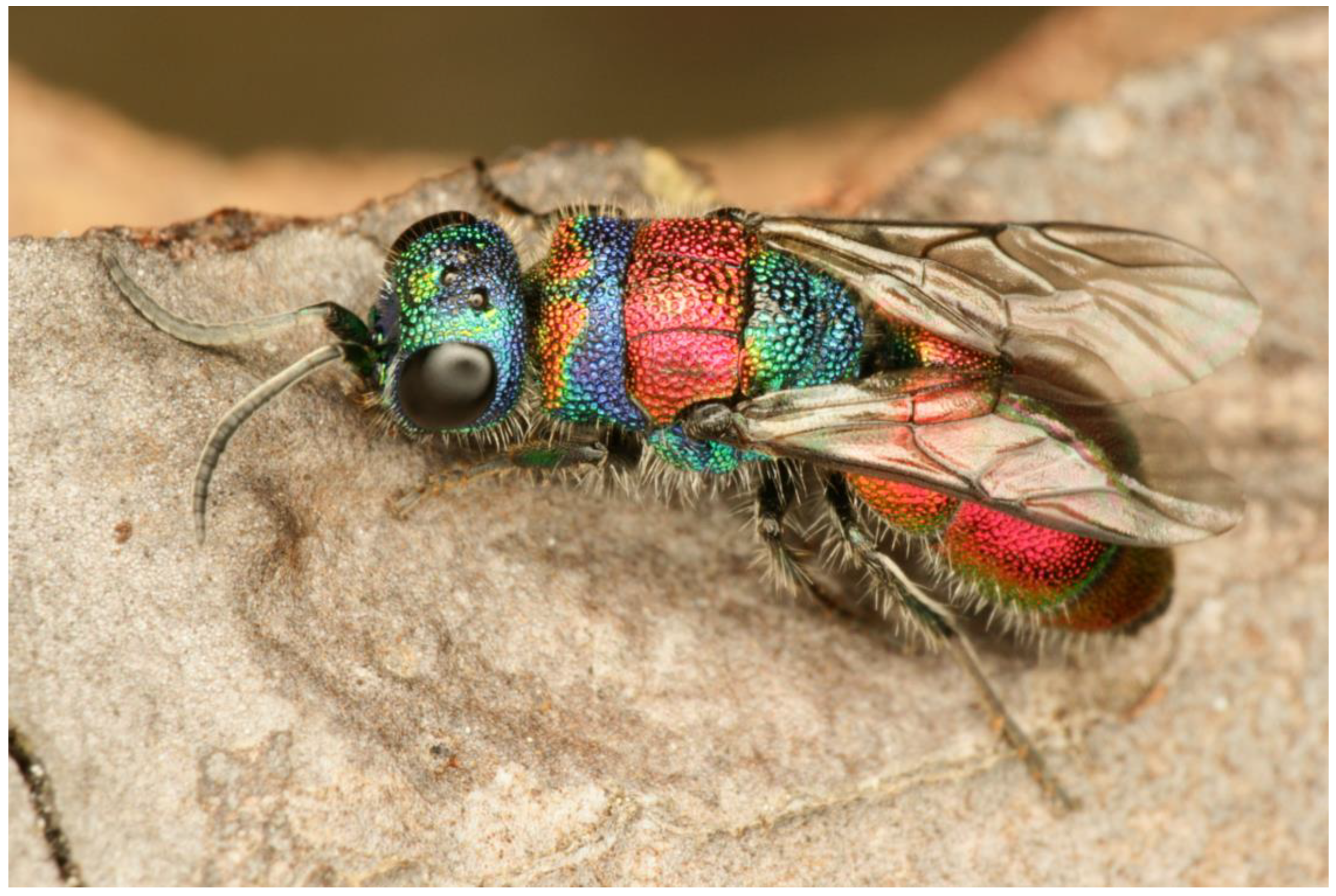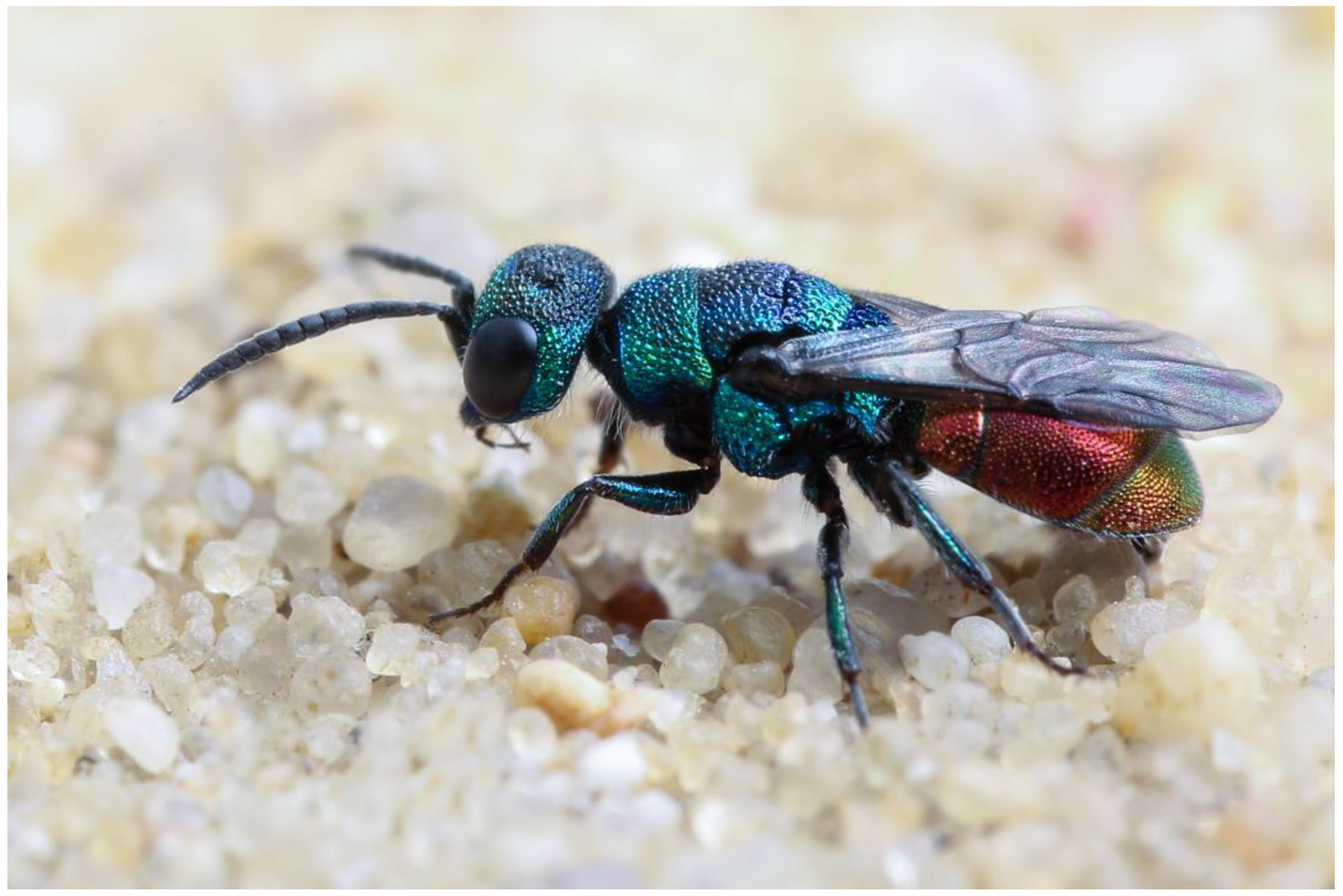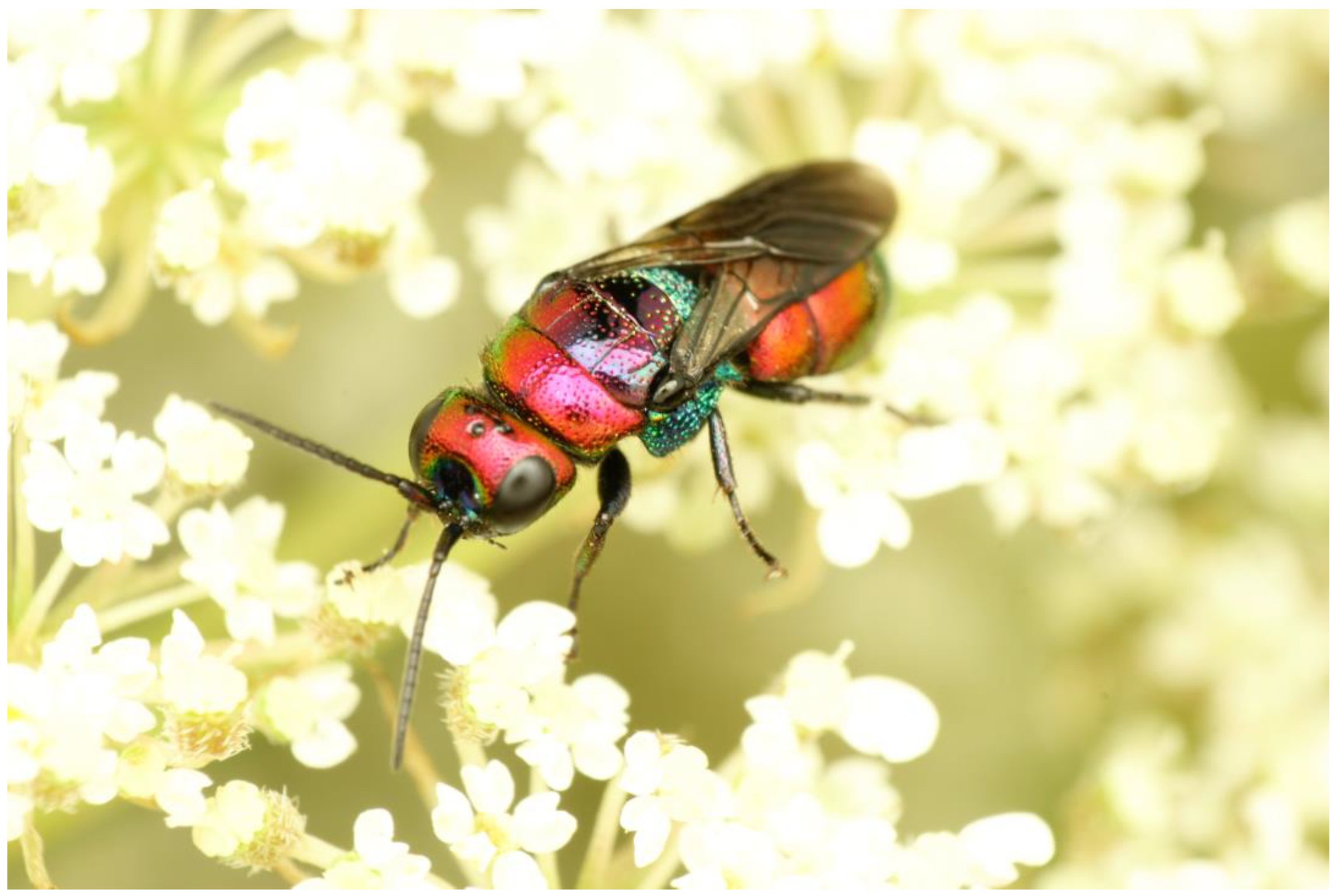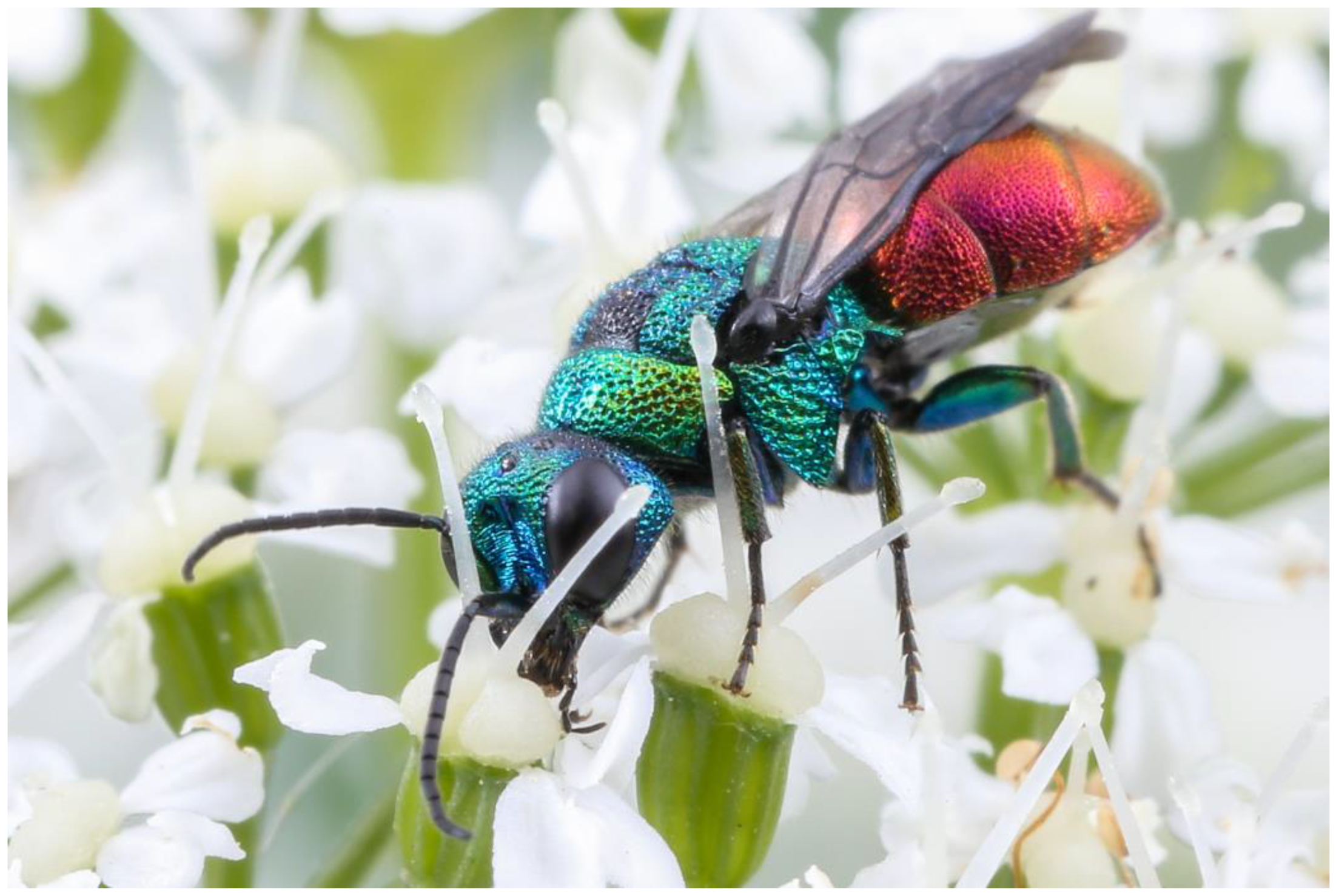DNA Barcoding of German Cuckoo Wasps (Hymenoptera: Chrysididae) Suggests Cryptic Species in Several Widely Distributed Species
Simple Summary
Abstract
1. Introduction
2. Materials and Methods
3. Results
4. Discussion

- Chrysis bicolor Lepeletier, 1806 (Figure 1)
- Chrysis leachii Shuckard, 1837
- Chrysis succincta Linnaeus, 1767 (Figure 2)

- Chrysis ignita species group
- Chrysis mediata Linsenmaier, 1951 and Chrysis solida Haupt, 1956
- Chrysis ignita (Linnaeus, 1758) and Chrysis impressa Schenck, 1856
- Chrysis parietis Budrys, 2016 and Chrysis schencki Linsenmaier, 1968
- Hedychrum viridiaureum Tournier, 1877

- Hedychridium roseum (Rossi, 1790)

- Hedychridium rossicum Gussakowskij, 1948
- Holopyga chrysonota (Förster, 1853)

- Holopyga fervida (Fabricius, 1781) (Figure 5)
- Holopyga generosa (Förster 1853) (Figure 6)

- Omalus aeneus (Fabricius, 1787) and Omalus puncticollis Mocsáry, 1887
5. Conclusions
Supplementary Materials
Author Contributions
Funding
Data Availability Statement
Acknowledgments
Conflicts of Interest
References
- Niehuis, O. Chrysididae. In Verzeichnis der Hautflügler Deutschlands (Entomofauna Germanica 4); Dathe, H.H., Taeger, A., Blank, S.M., Eds.; Entomologische Nachrichten und Berichte: Dresden, Germany, 2001; Volume 7, pp. 119–123. [Google Scholar]
- Schmid-Egger, C. Rote Liste und Gesamtartenliste der Wespen Deutschlands. Hymenoptera, Aculeata: Grabwespen (Ampulicidae, Crabronidae, Sphecidae), Wegwespen (Pompilidae), Goldwespen (Chrysididae), Faltenwespen (Vespidae), Spinnenameisen (Mutillidae), Dolchwespen (Scoliidae), Rollwespen (Tiphiidae) und Keulhornwespen (Sapygidae). In Rote Liste gefährdeter Tiere, Pflanzen und Pilze Deutschlands. Band 3: Wirbellose Tiere (Teil 1); Binot-Hafke, M., Balzer, S., Becker, N., Gruttke, H., Haupt, H., Hofbauer, N., Ludwig, G., Matzke-Hajek, G., Strauch, M., Eds.; Landwirtschaftsverlag, Naturschutz Biologische Vielfalt: Münster, Germany, 2012; Volume 70, pp. 419–465. [Google Scholar]
- Wiesbauer, H.; Rosa, P.; Zettel, H. Die Goldwespen Mitteleuropas. Biologie, Lebensräume, Artenporträts; Verlag Eugen Ulmer: Stuttgart, Germany, 2020; 248p. [Google Scholar]
- Pauli, T.; Castillo-Cajas, R.F.; Rosa, P.; Kukowka, S.; Berg, A.; van den Berghe, E.; Fornoff, F.; Hopfenmüller, S.; Niehuis, M.; Peters, R.S.; et al. Phylogenetic analysis of cuckoo wasps (Hymenoptera: Chrysididae) reveals a partially artificial classification at the genus level and a species-rich clade of bee parasitoids. Syst. Entomol. 2019, 44, 322–335. [Google Scholar] [CrossRef]
- Kroiss, J.; Strohm, E.; Vandenbem, C.; Vigneron, J.-P. An epicuticular multilayer reflector generates the iridescent coloration in chrysidid wasps (Hymenoptera, Chrysididae). Sci. Nat. 2009, 96, 983–986. [Google Scholar] [CrossRef]
- Rosa, P.; Forshage, M.; Forshage, M.; Paukkunen, J.; Soon, V. Cleptes pallipes Lepeletier synonym of Cleptes semiauratus (Linnaeus) and description of Cleptes striatipleuris sp. nov. (Hymenoptera: Chrysididae, Cleptinae). Zootaxa 2015, 4039, 543–552. [Google Scholar] [CrossRef]
- Rosa, P.; Lelej, A.S.; Pavesi, M. A new synonymy of Hedychridium rossicum Gussakovskij, 1948 = H. valesiense Linsenmaier, 1959, syn. n. (Hymenoptera: Chrysididae). Far East. Entomol. 2017, 344, 7–9. [Google Scholar] [CrossRef]
- Rosa, P.; Pavesi, M.; Soon, V.; Niehuis, O. Pseudochrysis Semenov, 1891 is the valid genus name for a group of cuckoo wasps frequently referred to as Pseudospinolia Linsenmaier, 1951 (Hymenoptera, Chrysididae). Dtsch. Entomol. Z. 2017, 64, 69–75. [Google Scholar] [CrossRef]
- Orlovskytė, S.; Budrys, E.; Budrienė, A.; Radzevičiūtė, R.; Soon, V. Sibling species in the Chrysis ignita complex: Molecular, morphological and trophic differentiation of Baltic species, with a description of two new cryptic species (Hymenoptera: Chrysididae). Syst. Entomol. 2016, 41, 771–793. [Google Scholar] [CrossRef]
- Soon, V.; Castillo-Cajas, R.F.; Johansson, N.; Paukkunen, J.; Rosa, P.; Ødegaard, F.; Schmitt, T.; Niehuis, O. Cuticular hydrocarbon profile analyses help clarifying the species identity of dry-mounted cuckoo wasps (Hymenoptera: Chrysididae), including type material, and reveal evidence for a cryptic species. Insect Syst. Divers. 2021, 5, 1–12. [Google Scholar] [CrossRef]
- Hebert, P.D.N.; Cywinska, A.; Ball, S.L.; deWaard, J.R. Biological identifications through DNA barcodes. Proc. R. Soc. B Biol. Sci. 2003, 270, 313–321. [Google Scholar] [CrossRef] [PubMed]
- Tautz, D.; Arctander, P.; Minelli, A.; Thomas, R.H.; Vogler, A.P. A plea for DNA taxonomy. Trends Ecol. Evol. 2003, 18, 70–74. [Google Scholar] [CrossRef]
- Bocca, F.M.; Picciau, L.; Rosa, P.; Wood, T.J.; Caprio, E.; Niehuis, O.; Alma, A. New host-parasitoid association and the Trojan horse strategy adopted by the cuckoo wasp Elampus bidens with two vectors of Flavescence Dorée: Scaphoideus titanus and Orientus ishidae. Entomol. Gen. 2023, 43, 849–859. [Google Scholar] [CrossRef]
- Homer; Wilson, E.R. The Iliad; Norton & Company: New York, NY, USA, 2023; 848p. [Google Scholar]
- Eberle, J.; Ahrens, D.; Mayer, C.; Niehuis, O.; Misof, B. A plea for standardized nuclear markers in metazoan DNA taxonomy. Trends Ecol. Evol. 2020, 35, 336–345. [Google Scholar] [CrossRef] [PubMed]
- Dietz, L.; Eberle, J.; Mayer, C.; Kukowka, S.; Bohacz, C.; Baur, H.; Espeland, M.; Huber, B.A.; Hutter, C.; Mengual, X.; et al. Standardized nuclear markers improve and homogenize species delimitation in Metazoa. Methods Ecol. Evol. 2023, 14, 543–555. [Google Scholar] [CrossRef]
- Niehuis, O.; Wägele, J.W. Phylogenetic analysis of the mitochondrial genes LSU rRNA and COI suggests early adaptive differentiation of anal teeth in chrysidine cuckoo wasps (Hymenoptera: Chrysididae). Mol. Phylogenet. Evol. 2004, 30, 615–622. [Google Scholar] [CrossRef] [PubMed]
- Rosa, P.; Wood, T.; Silva, T.L.; Veríssimo, J.; Mata, V.A.; Michez, D.; Beja, P.; Ferreira, S. The InBIO Barcoding Initiative Database: Contribution to the knowledge on DNA barcodes of cuckoo wasps, with the description of new species from the Iberian Peninsula (Hymenoptera, Chrysididae). Biodivers. Data J. 2023, 11, e98743. [Google Scholar] [CrossRef] [PubMed]
- Roslin, T.; Somervuo, P.; Pentinsaari, M.; Hebert, P.D.N.; Agda, J.; Ahlroth, P.; Anttonen, P.; Aspi, J.; Blagoev, G.; Blanco, S.; et al. A molecular-based identification resource for the arthropods of Finland. Mol. Ecol. Resour. 2022, 22, 803–822. [Google Scholar] [CrossRef]
- Soon, V.; Saarma, U. Mitochondrial phylogeny of the Chrysis ignita (Hymenoptera: Chrysididae) species group based on simultaneous Bayesian alignment and phylogeny reconstruction. Mol. Phylogenet. Evol. 2011, 60, 13–20. [Google Scholar] [CrossRef]
- Hendrich, L.; Balke, M.; Haszprunar, G.; Hausmann, A.; Hebert, P.; Schmidt, S. Barcoding Fauna Bavarica—Capturing Central European Animal Diversity. In Tools for Identifying Biodiversity: Progress and Problems; Nimis, P.L., Vignes Lebbe, R., Eds.; EUT Edizioni Università di Trieste: Trieste, Italy, 2010; 347p. [Google Scholar]
- Hausmann, A.; Hendrich, L.; Balke, M.; Morinière, J.; Schmidt, S.; Segerer, A.; Hebert, P.D.N.; Haszprunar, G. A Major Contribution of the ZSM to the Genetic Library of Life: 35,000 Insect Species Barcoded in 7 Years. Abstracts. In Proceedings of the BioSyst. EU 2013, Global Systematics, Vienna, Austria, 18–22 February 2013; p. 86. [Google Scholar]
- Schmidt, S.; Schmid-Egger, C.; Morinière, J.; Haszprunar, G.; Hebert, P.D.N. DNA barcoding largely supports 250 years of classical taxonomy: Identifications for Central European bees (Hymenoptera, Apoidea partim). Mol. Ecol. Resour. 2015, 15, 985–1000. [Google Scholar] [CrossRef]
- Schmid-Egger, C.; van Achterberg, K.; Neumeyer, R.; Morinière, J.; Schmidt, S. Revision of the West Palaearctic Polistes Latreille, with the descriptions of two species—An integrative approach using morphology and DNA barcodes (Hymenoptera, Vespidae). ZooKeys 2017, 713, 53–112. [Google Scholar] [CrossRef]
- Schmid-Egger, C.; Straka, J.; Ljubomirov, T.; Blagoev, G.A.; Morinière, J.; Schmidt, S. DNA barcodes identify 99 percent of apoid wasp species (Hymenoptera: Ampulicidae, Crabronidae, Sphecidae) from the Western Palearctic. Mol. Ecol. Resour. 2018, 19, 476–484. [Google Scholar] [CrossRef]
- Schmid-Egger, C.; Schmidt, S. Unexpected diversity in Central European Vespoidea (Hymenoptera, Mutillidae, Myrmosidae, Sapygidae, Scoliidae, Tiphiidae, Thynnidae, Vespidae), with description of two species of Smicromyrme Thomson, 1870. Zookeys 2021, 1062, 49–72. [Google Scholar] [CrossRef]
- Wurdack, M.; Herbertz, S.; Dowling, D.; Kroiss, J.; Strohm, E.; Baur, H.; Niehuis, O.; Schmitt, T. Striking cuticular hydrocarbon dimorphism in the mason wasp Odynerus spinipes and its possible evolutionary cause (Hymenoptera: Chrysididae, Vespidae). Proc. R. Soc. B Biol. Sci. 2015, 282, 20151777. [Google Scholar] [CrossRef]
- Castillo, R.; Wurdack, M.; Pauli, P.; Keller, A.; Feldhaar, H.; Polidori, C.; Niehuis, O.; Schmitt, T. Evidence for a chemical arms race between cuckoo wasps of the genus Hedychrum and their distantly related host apoid wasps. BMC Ecol. Evol. 2022, 22, 138. [Google Scholar] [CrossRef]
- Ivanova, N.V.; Dewaard, J.R.; Hebert, P.D.N. An inexpensive, automation-friendly protocol for recovering high-quality DNA. Mol. Ecol. Notes 2006, 6, 998–1002. [Google Scholar] [CrossRef]
- Pauli, T.; Meusemann, K.; Kukowka, S.; Sann, M.; Donath, A.; Mayer, C.; Oeyen, J.P.; Ballesteros, Y.; Berg, A.; van den Berghe, E.; et al. Analysis of RNA-seq, DNA target enrichment, and Sanger nucleotide sequence data resolves deep splits in the phylogeny of cuckoo wasps (Hymenoptera: Chrysididae). Insect Syst. Diver. 2021, 5, 1–14. [Google Scholar] [CrossRef]
- Kimura, M. A simple method for estimating evolutionary rates of base substitutions through comparative studies of nucleotide sequences. J. Mol. Evol. 1980, 16, 111–120. [Google Scholar] [CrossRef] [PubMed]
- Ratnasingham, S.; Hebert, P.D.N. A DNA-based registry for all animal species: The barcode index number (BIN) system. PLoS ONE 2013, 8, e66213. [Google Scholar] [CrossRef]
- Rosa, P.; Xu, Z. Annotated type catalogue of the Chrysididae (Insecta, Hymenoptera) deposited in the collection of Maximilian Spinola (1780–1857), Turin. ZooKeys 2015, 471, 1–96. [Google Scholar] [CrossRef] [PubMed]
- Haris, A. Hymenoptera Research in the Carpathian Basin (Hymenoptera: Aculeata). Nat. Som. 2016, 29, 5–246. [Google Scholar] [CrossRef]
- International Commission on Zoological Nomenclature (ICZN). International Code on Zoological Nomenclature, 4th ed.; ITZN: London, UK, 1999; 306p. [Google Scholar]
- Backer, D.B. The Hymenoptera collections of William Edward Shuckard and the dispersal of his type material. Beitr. Ent. 1998, 48, 157–174. [Google Scholar]
- Mocsáry, A. Monographia Chrysididarum Orbis Terrarum Universi; Academia Hungarica Scientarum: Budapest, Hungary, 1889; 643p. [Google Scholar]
- Frommer, U.; Tischendorf, S. Kommentierte Rote Liste der Goldwespen Hessens. 1. Fassung; Hessisches Landesamt für Naturschutz, Umwelt und Geologie: Wiesbaden, Germany, 2021; 248p. [Google Scholar]
- Oshibah, A.D.A.; Salem, M.M.; Hossni, H.T.; Galhoum, A.M. Key for identification of the species included in the genus Chrysis Linnaeus (Hymenoptera, Chrysididae) of Egypt with a new record. Egypt. Acad. J. Biol. Sci. 2017, 10, 27–36. [Google Scholar] [CrossRef]
- Józan, Z. Fundamental data of the chrysid (cuckoo) wasp fauna of the South-Transdanubia, Hungary (Hymenoptera, Chrysididae). Nat. Som. 2018, 31, 89–106. [Google Scholar]
- Özbek, H.; Strumia, F. Research on the subfamily Chrysidinae (Hymenoptera: Chrysididae) Fauna of Turkey with distributional evaluation. Acta Entomol. Serbica 2019, 23, 75–104. [Google Scholar]
- Rosa, P.; Lelej, A.S.; Belokobylskij, S.A.; Vinokurov, N.B.; Zaytseva, L.A. Illustrated and annotated check-list of the Russian cuckoo wasps (Hymenoptera, Chrysididae). Entomofauna Suppl. 2019, 23, 1–360. [Google Scholar]
- Ruchin, A.; Antropov, A. Wasp fauna (Hymenoptera: Bethylidae, Chrysididae, Dryinidae, Tiphiidae, Mutillidae, Scoliidae, Pompilidae, Vespidae, Sphecidae, Crabronidae & Trigonalyidae) of Mordovia State Nature Reserve and its surroundings in Russia. J. Threat. Taxa 2019, 11, 13195–13250. [Google Scholar]
- Majzlan, O.; Tyrner, P. Chrysididae family (Hymenoptera) of Horšianska dolina valley (Ipel’ská pahorkatina highland), south-west Slovakia. Ochr. Prírody 2018, 32, 10–15. [Google Scholar]
- Falahatpisheh, A.; Fallahzadeh, M.; Dousti, A.F.; Strumia, F.; Saghaei, N. A survey of the genus Chrysis (Hymenoptera: Chrysididae) in Fars province, with six new records for Iranian fauna. J. Entomol. Res. 2021, 12, 29–37. [Google Scholar]
- Vinokurov, N.B. Dynamics of the abundance of cuckoo wasps (Hymenoptera, Chrysididae) in the conditions of the altitudinal-belt heterogeneity of the North Caucasus. BIO Web Conf. Mt. Ecosyst. Their Compon. 2021, 35, 23. [Google Scholar] [CrossRef]
- Vinokurov, N.B. Species abundance and ecological characteristics of cuckoo wasps of the tribe (Chrysidini) in plant communities of the water protection zone of the Kuma and Podkumok rivers (the North Caucasus). AIP Conf. Proc. 2021, 2388, 40019. [Google Scholar]
- Linsenmaier, W. Revision der Familie Chrysididae (Hymenoptera) mit besonderer Berücksichtigung der europäischen Spezies. Mitt. Schweiz. Entomol. Ges. 1959, 32, 1–232. [Google Scholar]
- Paukkunen, J.; Berg, A.; Soon, V.; Ødegaard, F.; Rosa, P. An illustrated key to the cuckoo wasps (Hymenoptera, Chrysididae) of the Nordic and Baltic countries, with description of a new species. ZooKeys 2015, 548, 1–116. [Google Scholar] [CrossRef]
- Soon, V.; Budrys, E.; Orlovskytė, S.; Paukkunen, J.; Ødegaard, F.; Ljubomirov, T.; Saarma, U. Testing the validity of Northern European species in the Chrysis ignita species group (Hymenoptera: Chrysididae) with DNA Barcoding. Zootaxa 2014, 3786, 301–330. [Google Scholar] [CrossRef] [PubMed]
- van der Smissen, J. Schlüssel zur Determination der Goldwespen der engeren ignita-Gruppe (Hymenoptera Aculeata: Chrysididae). Verh. Ver. Naturw. Heimatforsch. Hamburg 2010, 43, 4–184. [Google Scholar]
- Ohl, M. Sphecidae. In Verzeichnis der Hautflügler Deutschlands (Entomofauna Germanica 4); Dathe, H.H., Taeger, A., Blank, S.M., Eds.; Entomologische Nachrichten und Berichte: Dresden, Germany, 2001; Volume 7, pp. 137–143. [Google Scholar]
- Schmid-Egger, C.; Krumm, G. Beutespektrum und Bestandsentwicklung von Philanthus coronatus (Thunberg, 1784) in Deutschland (Hymenoptera, Crabronidae). Ampulex 2012, 4, 39–42. [Google Scholar]
- Niehuis, O. Molekular-Systematische Unteresuchungen an Chrysididen (Insecta: Hymenoptera). Master’s Thesis, Ruhr University of Bochum, Bochum, Germany, 2000; 182p. [Google Scholar]
- Arens, W. Beitrag zur Taxonomie griechischer Goldwespen, mit Beschreibung dreier neuer Arten (Hymenoptera: Chrysididae). Linz. Biol. Beitr. 2004, 36, 741–760. [Google Scholar]
- Arens, W. Revision der Hedychridium roseum-Gruppe in Kleinasien (Hymenoptera: Chrysididae), mit Neubewertung zahlreicher europäischer Taxa und Beschreibung zweier neuer Arten. Linz. Biol. Beitr. 2010, 42, 401–458. [Google Scholar]
- Rosa, P.; Madl, M.; Zettel, H.; Zimmermann, D. Annotated catalogue of the Chrysididae (Insecta, Hymenoptera) types deposited at the Naturhistorisches Museum, Vienna. Ann. Naturhist. Mus. Wien Ser. B 2020, 122, 17–140. [Google Scholar]
- Schmid-Egger, C. Ergänzungen zur Taxonomie und Verbreitung von zwei Arten der Gattung Hedychridium Abeille, 1878 (Hymenoptera, Chrysididae). Linzer Biol. Beitr. 1995, 27, 401–411. [Google Scholar]
- Rosa, P.; Ratzlaff, C. First record of Chrysellampus sculpticollis (Abeille de Perrin, 1878) in Germany (Hymenoptera: Chrysididae). Ampulex 2018, 10, 17–19. [Google Scholar]
- van der Smissen, J. Bilanz aus 20 Jahren entomologischer Aktivitäten (1987–2007) (Hymenoptera Aculeata). Teil II. Die Goldwespen der Kettner-Belegsammlung sowie untersuchte Exemplare der engeren ignita-Gruppe der Universität Hamburg (Hymenoptera Aculeata: Chrysididae). Verh. Ver. Naturw. Heimatforsch. Hamburg 2010, 43, 185–195. [Google Scholar]
- Padial, J.M.; Miralles, A.; De La Riva, I.; Vences, M. The integrative future of taxonomy. Front. Zool. 2010, 7, 16. [Google Scholar] [CrossRef]
Disclaimer/Publisher’s Note: The statements, opinions and data contained in all publications are solely those of the individual author(s) and contributor(s) and not of MDPI and/or the editor(s). MDPI and/or the editor(s) disclaim responsibility for any injury to people or property resulting from any ideas, methods, instructions or products referred to in the content. |
© 2024 by the authors. Licensee MDPI, Basel, Switzerland. This article is an open access article distributed under the terms and conditions of the Creative Commons Attribution (CC BY) license (https://creativecommons.org/licenses/by/4.0/).
Share and Cite
Schmid-Egger, C.; Schmidt, S.; Rosa, P.; Niehuis, O. DNA Barcoding of German Cuckoo Wasps (Hymenoptera: Chrysididae) Suggests Cryptic Species in Several Widely Distributed Species. Insects 2024, 15, 850. https://doi.org/10.3390/insects15110850
Schmid-Egger C, Schmidt S, Rosa P, Niehuis O. DNA Barcoding of German Cuckoo Wasps (Hymenoptera: Chrysididae) Suggests Cryptic Species in Several Widely Distributed Species. Insects. 2024; 15(11):850. https://doi.org/10.3390/insects15110850
Chicago/Turabian StyleSchmid-Egger, Christian, Stefan Schmidt, Paolo Rosa, and Oliver Niehuis. 2024. "DNA Barcoding of German Cuckoo Wasps (Hymenoptera: Chrysididae) Suggests Cryptic Species in Several Widely Distributed Species" Insects 15, no. 11: 850. https://doi.org/10.3390/insects15110850
APA StyleSchmid-Egger, C., Schmidt, S., Rosa, P., & Niehuis, O. (2024). DNA Barcoding of German Cuckoo Wasps (Hymenoptera: Chrysididae) Suggests Cryptic Species in Several Widely Distributed Species. Insects, 15(11), 850. https://doi.org/10.3390/insects15110850




